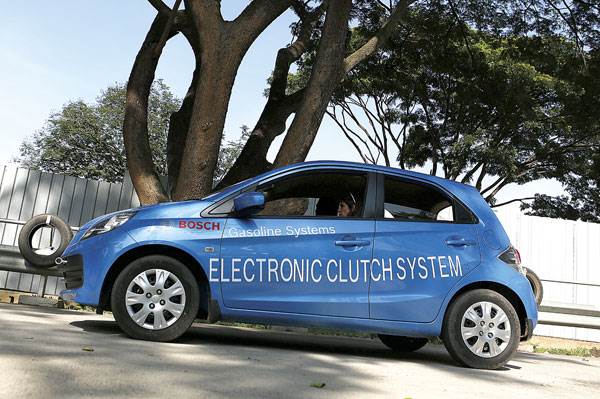The healthy consumer response to the automated manual transmission variant of the Maruti Celerio shows that India is ready for clutch-free driving. While the market may not be ready for the more expensive pure automatics, traffic congestion in cities, with stop-and-start driving, is paving the way for automatic transmission vehicles here. Technologies that give users an automatic-like driving experience are set to gain ground.
Among the technologies that could hold sway is Bosch’s eClutch. Unlike a fully automatic transmission, the eClutch automates the clutch only, not the transmission. The cable-less clutch pedal transmits an electric signal to an actuator, which decouples the clutch. In congested traffic conditions, this allows the driver in a manual transmission car to use first gear without using the clutch.
I had a feel of this when I took to the wheel of a Honda Brio equipped with an eClutch at a Bosch Tech day event, held in Bangalore on October 30. I could shift gears without pressing the clutch. A special sensor detects the start of a gear shift and adjusts engine speed, which facilitates a smooth gear change. What is significant is that the Brio as a test car reflects Bosch’s focus on offering the technology in the compact car segment first. In terms of cost, Bosch says the eClutch is ‘significantly less’ than a conventional auto transmission. This makes it a strong proposition in a segment with price-conscious buyers.
Apart from the cost factor, the eClutch promises savings in fuel and lower emissions. Bosch claims that in start-stop coasting mode, the fuel consumption can come down by 10 percent. In India though, Bosch will initially offer idle coasting. “Europe is doing it (eClutch) with a big-bang approach. For them, carbon dioxide reduction is the main factor. We will create the subsystem where we pick what is necessary, enter and then slowly make our way up the value chain,” says Sandeep N, regional president India, Gasoline Systems, Bosch India. The eClutch may well be introduced here in 2016.
Bosch also plans some inorganic moves in growing its two-wheeler business through new- age technologies. One motorbike that caught this correspondent’s eye at the Bosch facility is a ‘connected bike’. On the outside, it looks like any bike. However, it is the software inside that makes it interesting. Bosch engineers have developed a software development kit platform which offers developers to come up with a variety of mobile applications (apps). The connection with the bike is established through Bluetooth.
So, a trial app called Bikebuddy can provide real-time information on fuel efficiency as well as record fuel consumption and speed at pre-set intervals. Another app called Bikey offers features such as immobilising the bike, automatic lock when ignition is off or unlock ignition and fuel injection through a unique PIN code. An app called Bike DTC is designed for diagnosing the health of the bike under set parameters. “It is not a fantasy. Everything that you can think about, you can get on your mobile. On emergency mode, suppose there may be a breakdown after 10km, your mobile will let you know where you will get support and everything,” says Friedrich Boecking, regional president, Bosch India.
The above project is being conducted on a KTM Duke, a premium bike. Bosch is also developing some technologies for the mass bike market. One product is the stop-start feature. Along with it, Bosch’s low cost EMS and a low-cost ABS for two-wheelers in India and India-like markets will play key roles in realising the German supplier’s plans of being a major player in the two-wheeler industry too.
Sumantra Barooah


-copy-copy.jpg&w=700&c=1)

Comments
Member Login
Personal Details
No comments yet. Be the first to comment.